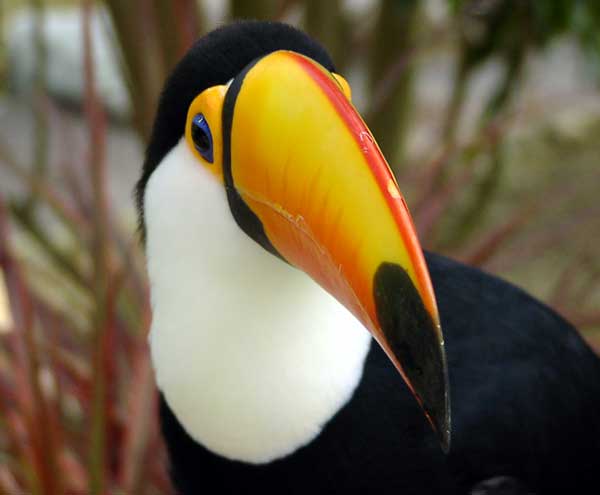- Toco Toucan
Taxobox
name = Toco Toucan
status = LC | status_system = IUCN3.1

regnum =Animal ia
phylum = Chordata
classis = Aves
ordo =Piciformes
familia =Ramphastidae
genus = "Ramphastos "
species = "R. toco"
binomial = "Ramphastos toco"
binomial_authority =Statius Muller , 1776The Toco Toucan ("Ramphastos toco") is the largest and arguably best known
species in thetoucan family. It is found in semi-open habitats throughout a large part of central and easternSouth America . It is a common attraction inzoo s.Description
The Toco Toucan has a striking
plumage with a mainly black body, a white throat, chest and uppertail-coverts, and red undertail-coverts. What appears to be a blue iris is actually thin blue skin around the eye. This blue skin is surrounded by another ring of bare, orange skin. The most noticeable feature, however, is its huge bill, which is yellow-orange, tending to deeper reddish-orange on its lower sections andculmen , and with a black base and large spot on the tip. It looks heavy, but as in other toucans it is relatively light because the inside largely is hollow. The tongue is nearly as long as the bill and very flat. With a total length of 55-65 cm (22-26 in), incl. a bill that measures almost 20 cm (8 in), and a weight of 500-860 g (17.5-30 oz), it is the largest species of toucan and the largest representative of the orderPiciformes . [http://www.nfss.org/Birds/Species/Softbill/Toucans/Toco.html Toco Toucan (Ramphastos toco) ] ] The average Toco Toucan is 700 grams. [http://www.treknature.com/gallery/North_America/United_States/photo35812.htm] Males are larger than females, but otherwise the sexes are alike. Juveniles are duller and shorter-billed than adults. Its voice consists of a deep, coarse croaking, often repeated every few seconds. Also has a rattling call and will bill-clack.Distribution
It occurs in northern and eastern
Bolivia , extreme south-easternPeru , northernArgentina , eastern and centralParaguay , eastern and southernBrazil (excluding southernRio Grande do Sul , the dry regions dominated byCaatinga vegetation and coastal regions betweenCeará and Rio de Janeiro). Other disjunct populations occur along the lowerAmazon River (Ilha de Marajo west approximately to theMadeira River ), far northern Brazil inRoraima , and coastal regions of theGuianas . It only penetrates the Amazon in relatively open areas (e.g. along river corridors). It is resident, but local movements may occur.Habitat and status
It is, unlike the other members of the
genus "Ramphastos ", essentially a non-forest species. It can be found in a wide range of semi-open habitats such as woodland, savanna and other open habitats with scattered trees,Cerrado , plantations, forest-edge and even wooded gardens. It is mainly a species oflowland s, but occurs up to 1750 m (5750 ft) near theAndes in Bolivia. Because it prefers open habitats it is likely to benefit from the widespreaddeforestation intropical South America. It has a large range and except in the outer regions of its range, it typically is fairly common. It is therefore considered to be ofLeast Concern byBirdLife International . It is easily seen in thePantanal .Behavior
The Toco Toucan eats
fruit (e.g.fig s and "Passiflora edulis ") using its bill to pluck them from trees, but alsoinsects , and nestlings and eggs of birds. It also has been known to capture and eat small adult birds in captivity. The long bill is useful for reaching things that otherwise would be out-of-reach. It is also used to skin fruit and scare offpredator s. [http://www.kidsbiology.com/animals-for-children.php?animal=Toco%20Toucan KidsBiology.com - Ramphastos toco ] ] It is typically seen in pairs or small groups. In flight it alternates between a burst of rapid flaps with the relatively short, rounded wings and gliding. Nesting is seasonal, but timing differs between regions. The nest is typically placed high in a tree and consists of a cavity, at least part of which is excavated by the parent birds themselves. It has also been recorded nesting in holes in earth-banks and terrestrialtermite -nests. Their reproduction cycle is annual. The female usually lays two to four eggs a few days after mating. The eggs are incubated by both sexes and hatch after 17-18 days. These birds are very protective of themselves and of their babies.Aviculture
The Toco Toucan is sometimes kept in captivity, but has a high fruit diet and is sensitive to
hemochromatosis (an iron storage disease).Fact|date=July 2008 There is an ongoing population management plan that should help to revert the decreasing captive population of the Toco Toucan in AZA institutions. This will be the second management plan that is occurring since2001 . [ [http://www.nashvillezoo.org/piciformes/pdf/BreedingPMPTocoToucan.pdf Toco Toucan Population Management plan.] Riverbanks Zoo. Accessed2008-06-28 ]References
* Database entry includes justification for why this species is of Least Concern.
* Gilbert, A. (2002). Toco Toucan (Ramphastos toco). Pp. 270-271 in: del Hoyo, J., Elliott, A. & Sargatal, J. eds (2002). "Handbook of Birds of the World". Vol. 7. Jacamars to Woodpeckers. Lynx Edicions, Barcelona. ISBN 84-87334-37-7
* Restall, R., Rodner, C. & Lentino, M. (2006). "Birds of Northern South America - An Identification Guide." Christopher Helm, London. ISBN 0-7136-7242-0
* Short, L. & Horne, J. (2001). "Toucans, Barbets and Honeyguides." Oxford University Press, London. ISBN 0198546661
* Sick, H. (1993). "Birds of Brazil - A Natural History." Princeton University Press, West Sussex. ISBN 0691085692External links
* [http://www.emeraldforestbirds.com/EmeraldGallery.htm Extensive Gallery on Toucans]
* [http://www.mangoverde.com/birdsound/fam/fam102.html List of Toucans]
* [http://ibc.hbw.com/ibc/phtml/familia.phtml?idFamilia=101 Toucan videos] on the Internet Bird Collection
* [http://www.stlzoo.org/animals/abouttheanimals/birds/woodpeckerstoucans/tocotoucan.htm St. Louis Zoo] About the Animals
* [http://www.kidsbiology.com/animals-for-children.php?animal=Toco%20Toucan Biology of Toucans]
* [http://www.nashvillezoo.org/piciformes/pdf/BreedingPMPTocoToucan.pdf Nashville Zoo Toco Toucan Breeding]
* [http://www.nfss.org/Birds/Species/Softbill/Toucans/Toco.html Toucan Species]
* [http://www.bird-stamps.org/cspecies/10204100.htm Stamps] (forArgentina ,Bolivia ,Brazil ,French Guiana ,Guyana ,Paraguay )
* [http://vireo.acnatsci.org/search.html?VIREO_SESSION_ID=68bd29fd374429baab433789779bac27&Form=Search&SEARCHBY=Common&KEYWORDS=toco+toucan&showwhat=images&AGE=All&SEX=All&ACT=All&Search=Search&VIEW=All&ORIENTATION=All&RESULTS=24 Toco Toucan photo gallery] VIREOFurther reading
* [http://www.diostede.com/collared_aracari_toucan/natural_history_literature/ramphastos_toco_toco_toco_toucan.html Bibliography] of online, ornithological articles which explore the natural history of the Toco toucan, "Ramphastos toco toco".
Wikimedia Foundation. 2010.
